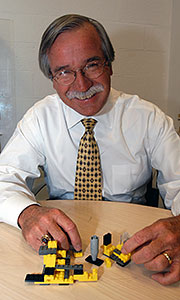Clicking together a small, safe nuclear power plant
Building a nuclear power plant can take decades—unless you follow a plan devised by MIT Professor Andrew Kadak of nuclear engineering. He likens his approach to building with Lego blocks: a small, meltdown-proof power plant would be made by “clicking together” prefabricated modules at building sites, cutting traditional construction time and costs in half.
While not quite as simple as building with Legos, the “plug-and-play” approach to construction coupled with the small size of the reactor could revolutionize the way nuclear plants are built. “If this works, the economic obstacle to building new nuclear plants will be removed,” said Kadak.
Nuclear power is in the limelight as a clean option for generating electricity, heat and even hydrogen. But the power plants of the future are likely to be different—small, safe and built by the dozen throughout energy-hungry countries. One promising candidate is the pebble bed high-temperature reactor in which uranium fuel is encased in billiard ball-sized graphite pebbles that cannot get hot enough to melt and are prepackaged for long-term disposal without reprocessing.
For the past decade, Kadak and others have been aggressively pursuing this technology. Tsinghua University in Beijing has put a demonstration plant through its paces, and China and South Africa are building full-size prototypes (about 160 MWe).
But for real success, the technology must be cost competitive. With a small plant like the pebble bed, the per-kilowatt cost would be high using the traditional approach of custom building each plant on site. Kadak’s cost-cutting idea is prefabrication. Sections of the plant would be made in factories, then shipped to the site and assembled. Nuclear submarines are now built using this approach, and the cost savings have been significant.
A user-friendly design
To make his plan work, Kadak adapted the pebble-bed design. He split the power plant up into modules, each of which fits inside an identical rectangular metal “space frame.” To accommodate shipping by truck or rail, he limited the dimensions and weight of each module. And he arranged the contents of each one so that attaching it to its neighbors—linking wires, piping, tubing, and so on—would be easy.
Kadak put together a step-by-step plan for manufacturing the modules; preparing the building site; transporting the modules; and positioning, aligning, and interconnecting them. Analyses confirmed that the plan is technically feasible and would result in significant savings over traditional methods.
In addition, the plants are user-friendly. Almost all of the modules are accessible from the plant exterior, so they can be removed and replaced with new ones if necessary.
Kadak’s concept may turn out to be ideal for China and other countries that seek to build small plants to serve growing populations in remote locations. Another potential use is for getting oil out of tar sands—an operation generally performed using heat from burning natural gas. Students in one of Kadak’s design classes have studied this option in detail. Given the enormous deposits of oil in tar sands in remote locations, energy companies could be extremely interested. “You never know. You might see oil companies building the next nuclear power plants,” Kadak said.


